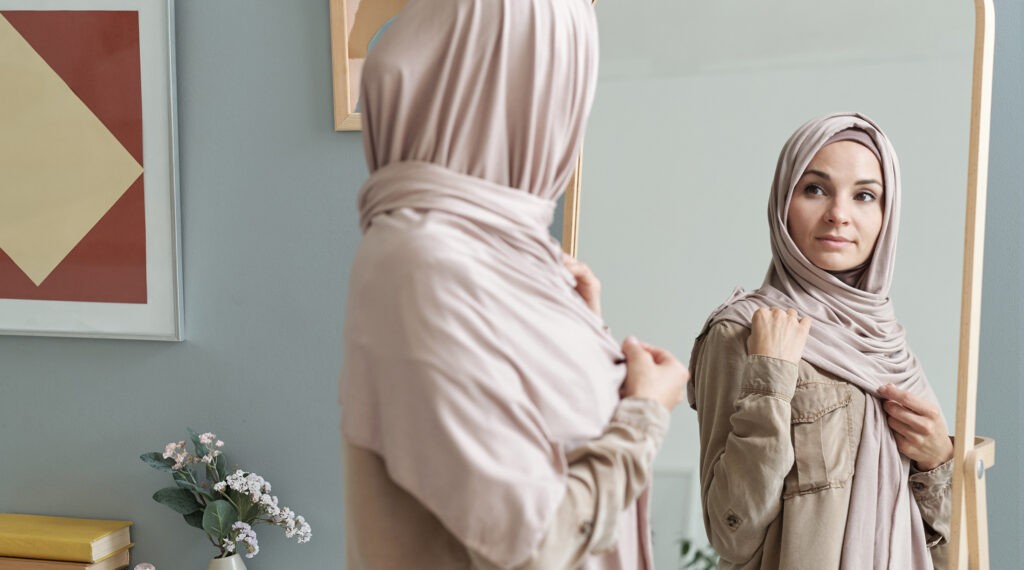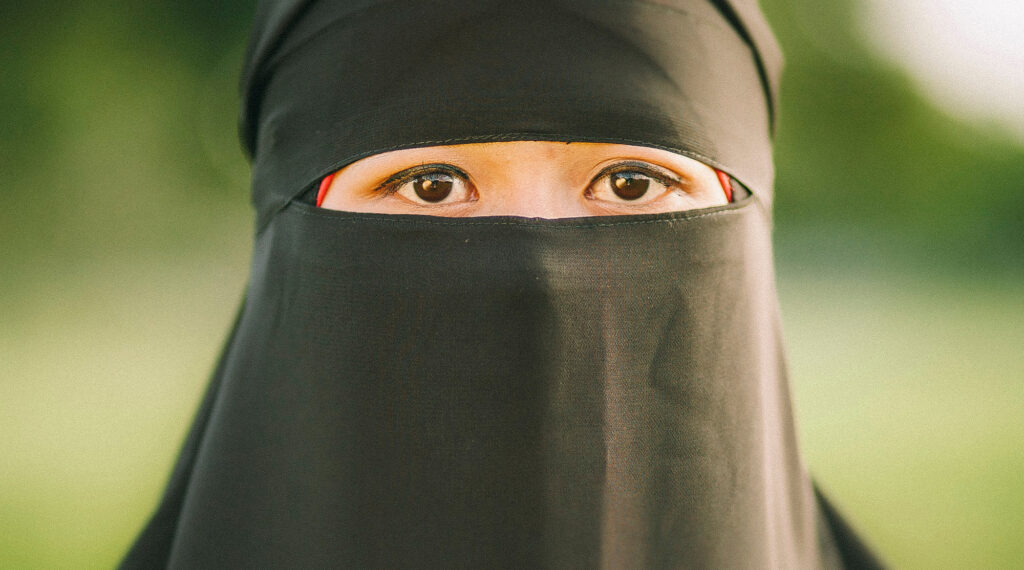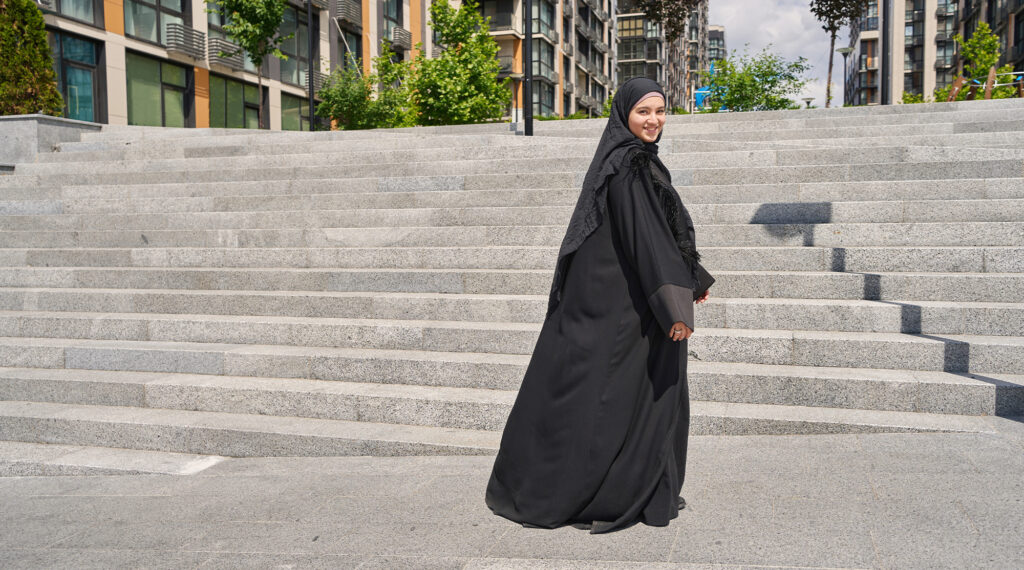The Hijab Meaning Explored

Muslim women cover their hair with veils out of obedience and devotion to God, which is the means to cultivating faith. In Surah al-Nur (24:31), God says, “And tell the believing women to lower their gaze and guard their private parts and not expose their adornment except that which [necessarily] appears; then let them extend their veils to cover their chests.” This hints at the hijab meaning and the fact that modesty is a form of respect for divine commands.
In societies in which women’s bodies are often objectified, the hijab can serve as a reminder of their autonomy and control over how they want to be perceived. It allows Muslim women to reaffirm their worth based on their morality, intelligence, and societal contributions in societies that objectify women’s bodies.
In North America, deciding to wear the hijab often comes after deep reflection on one’s identity. For practicing Muslim women, the hijab can serve as a way to define who they are in a society that values individuality and autonomy, especially considering that Muslim fashion designers are revamping how the hijab is viewed and worn, blending traditional styles with modern cuts and fabrics.
Muslim Dress for Women
Ayatollah Sayyid Ali al-Husayni al-Sistani offers guidance on Muslim dress for women. He clarifies the hijab’s role not just as a veil but as a shield preserving modesty and projecting an image of Islamic grace. His opinions include the following:
- The hijab envelops a woman’s beauty, covering the entire body except for the face and hands up to the wrists. This ensures that the attire neither defines the body’s contours nor detracts from the wearer’s essence through transparency or tightness.
- When in the presence of non-mahram men, the hijab serves as a barrier that safeguards a woman’s honor. It is a declaration of faith and an assertion of a Muslim woman’s commitment to modesty in public arenas.
- True to the spirit of Islamic modesty, the hijab should avoid things that make it a form of adornment (zeenah) as determined by people.
Ayatollah Sistani’s guidelines extend beyond personal wear to include interactions and societal participation in the following contexts:
- Professional and social engagements: Islam is not against women pursuing business and engaging in social activities, provided these do not compromise their hijab or their spiritual obligations.
- Employment challenges: In seeking employment, Muslim women should strive to find environments that respect their choice to wear the hijab. Removing it for a job opportunity is not permissible. It should be remembered that, by law, no one can refuse a qualified applicant based on religion, including the observance of religious attire.
Inspiring through faith, not compulsion
In line with Islam’s compassionate teachings, Ayatollah Sistani advises against compelling anyone to adopt the hijab. Instead, we should inspire others by way of our example and by educating them, making clear the hijab meaning by our role modeling.
A Muslim’s duty is to peacefully call to the way of God by standing up for what is right and forbidding what is wrong without exercising any form of coercion. Therefore, one should educate their community on the importance of the hijab and its great impact in ensuring a chaste and virtuous society.
When choosing which type of clothing to adopt, like an abaya, jilbab, khimar, niqab, or burka, it’s important to assess your comfort level so long as the minimum requirements of hijab are observed. Sayyid Sistani notes that the abaya is the best outer garment for a hijab. And among abayas, those that begin from the head are preferred to those that begin from the shoulder.
Contact us here for more details on the rules and wisdom of hijab.
The difference between hijab, niqab, and burka

For many Muslim women, the choice between wearing a hijab, niqab, or burka (also written as “burqa”) depends upon their particular context, as the definitions of social modesty can vary greatly from region to region. Here is a brief breakdown of three of the most popular terms used to describe women’s religious attire in Muslim societies.
Hijab meaning
The hijab is the most widely adopted form of veiling. It is what is required in modest dress, as the hijab meaning in the Quran is referenced in Surah 24:31. This verse emphasizes the importance of drawing veils over one’s bosom and not displaying one’s beauty except in front of certain people. For many hijabis, following this divine command is a daily reminder of their duty toward God.
Niqab
The niqab is another Muslim dress for women, it involves covering almost the entire face save the area around the eyes.
Burka
The burka (or burqa) covers the entire body, leaving only a mesh screen for the eyes. It is the most concealing of these three Islamic garments.
So what does Islamic law say about these various forms of covering oneself? Sayyid Sistani was asked questions about covering the face in regions where it is prevalent:
Question #1: Traditions and customs in our society require women to cover their faces, although some women seek to break this tradition while still adhering to the boundaries of Islamic hijab as in other Islamic countries. Is there a religious issue with this desire?
Answer #1: There is no issue if revealing [the face] is not intended to cause others to look in a forbidden manner, there is no fear of falling into sin, and it does not generally lead to temptation.
Question #2: I am from Al-Ahsa, Saudi Arabia. Is it permissible for me to wear the Islamic hijab without covering the face as is the custom in our area?
Answer #2: If revealing the face is not done to attract others to look [at the person’s face] in a forbidden manner, and there is no fear of falling into sin, and it does not lead to social disdain, then there is no objection.
These make clear that the appropriateness of wearing a hijab, niqab, or burka often involves social context. It should be remembered that, whether one wears a hijab, niqab, or burka, the importance of hijab in Islam is that it is a commitment to modesty and obedience to God.
Hijab meaning: a statement about modesty

In Islam, the hijab meaning is related to modesty and religious devotion. But in today’s world, hijab has come to serve as an identity marker. This evolution reflects how Muslim women use the hijab to show their faith and assert their roles in society.
More and more Muslim women are taking on leadership positions in politics, academia, and business while wearing the hijab. This challenges old stereotypes and proves that the hijab doesn’t prevent us from succeeding or being active in public life. When Muslim women in hijab influence policies and public opinion, they are asserting their ability to independently contribute to society while simultaneously being dedicated to God.
The hijab also stands for solidarity among women, whether Muslim or non-Muslim, in civil rights and social justice causes. Events like World Hijab Day invite non-Muslim women to wear the hijab for a day, helping to build understanding and tolerance. By being open-minded and compassionate, these individuals help bring awareness to the meaning of hijab.
Reach out to us here with your religious questions, and we’ll get back to you soon insha’Allah!

Leave a Comment:
You must be logged in to post a comment.